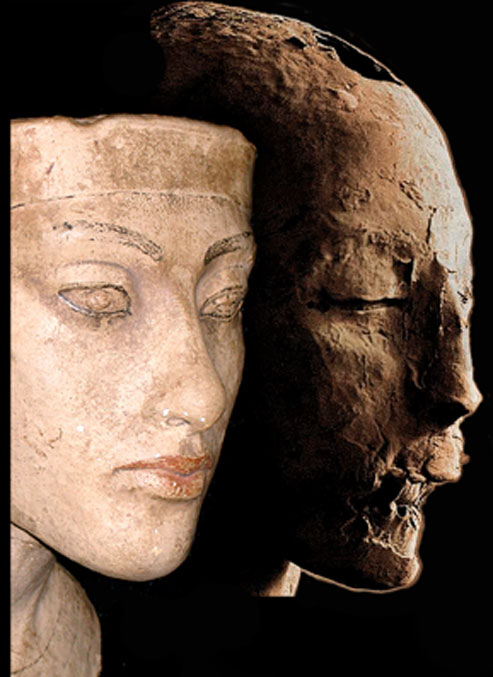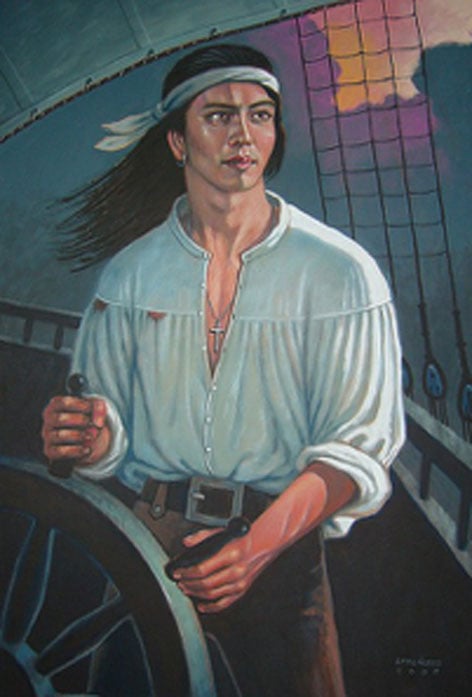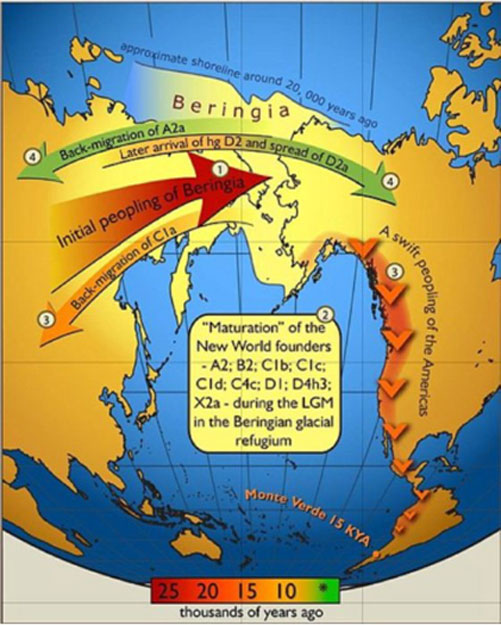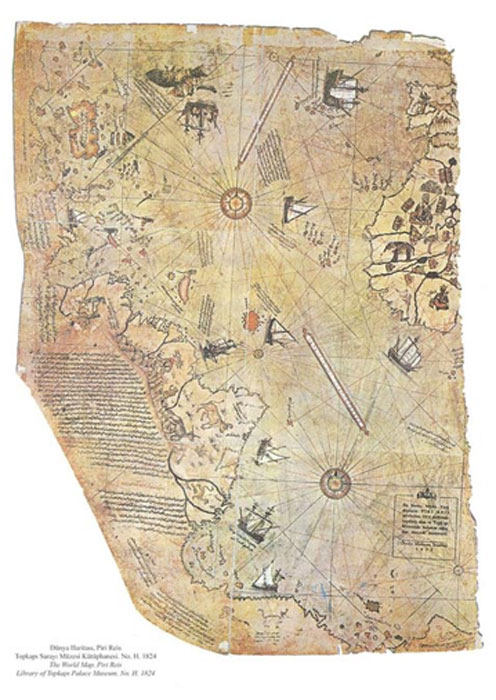
Mysterious Cocaine Mummies: Do They Prove Ancient Voyages Between Egypt and Americas?
Evidence which shows that ancient Egyptians had already crossed the Atlantic 3,000 years ago, long before Columbus in 1492, comes not only from the mimicking of cultural traditions as seen in Peru and the Canary Islands where evidence of trepanning and mummification has been found, but from the actual Egyptian mummies themselves.
Incredibly, in 1976, Dr. Michelle Lescott from the Museum of Natural History in Paris received a sample from the mummified remains of Egyptian Pharaoh Ramses the Great to study. Using an electron microscope, she discovered grains of tobacco clinging to the fibers of his bandages.
This initial discovery was berated by the authorities and her senior colleagues insisted that she had simply observed “contamination from modern sources”, maybe from some old archaeologist smoking a pipe in the vicinity, or perhaps she had found the traces of a workman’s sneeze? Tobacco first came to Europe from South America during the time of Columbus, 2700 years later, ruling out the possibility of tobacco being present during the reign of Ramses circa 1213 BC.
Some years later, Dr. Svelta Balabanova, a forensic toxologist at the Institute of Forensic Medicine at ULM, followed up on Dr. Lescott’s findings with yet more intriguing evidence. In order to eliminate the possibility of contemporary contamination, Dr. Balabanova obtained samples of intestinal tissue from deep inside Ramses, rather than the external layers of skin and cloth, and much to her amazement she discovered traces of cannabis, coca and tobacco laid down in his body cells ‘like rings on a tree’.
- Evidence Accumulates for Ancient Transoceanic Voyages, Says Geographer
- The Mysterious Holes of Peru: A Pre-Columbian Domestic Water Source for Trans-Oceanic Travelers? Part I
- Astonishing Human Heads: Do Satellite Photographs Now Prove Existence of Humans on Antarctica…6000 Years Ago? – Part I

Dr. Svelta Balabanova. (Author provided)
For her fellow researchers this still was not enough proof despite her excellent reputation, as such evidence contradicted conventional explanations of intercontinental contact thousands of years in the past. But, a decade later in 1992, seven ancient Egyptian mummies were flown from the Cairo Museum to Munich for further analysis.
Dr. Balabanova conducted a series of gas chromatography tests on samples of the seven mummies, one of which was the mummified remains of Henut Taui, 'the lady of the two lands', a priestess who lived sometime during the reign of the 21st Dynasty of ancient Egypt around 1000 BC. Each individual revealed the presence of nicotine and cocaine, and both the mummies and the results were deemed entirely credible.

Henut Taui, 'the lady of the two lands.' (Author provided)
Warm Up to Ancient Intercontinental Travel
‘It may be therefore implied that Egypt obtained these plants in trade with far flung urbanity from all over the ancient world’, wrote author/researcher Dr. Alexander Sumach. ‘Prepare to warm up to the plausible notion of intercontinental cultural contact that was either sustained, or else in play to some extent during every phase of human history.’
Professor Martin Bernal, a historian at Cornell University, is one of many scholars who conceded that ancient trade links which vastly predate present calculations must have existed; ‘We’re getting more and more evidence of world trade at an earlier stage.’ Besides, he is not alone in his hypothesis, more details of transoceanic contact can be found in my latest book The Myth Of Man.
History tells us that on September 20, 1519, Ferdinand Magellan set out from the coast of Spain with his expedition, intent on being the first man in recorded history to successfully circumnavigate the world by sea. Despite many sources claiming that he succeeded in this immense task, the truth of this tale states that having become embroiled in a local war, Magellan was killed during battle on April 27, 1521.SLXL
According to historic accounts, it was his personal slave Enrique of Malacca who ultimately succeeded where his master had failed, and managed to navigate the vast ocean the entire way around.

Enrique of Malacca. (Author provided)
History speaks of many ancient crossings of both the Atlantic and Pacific Oceans in the past but evidence has come to light which extends the timeline of these activities thousands of years beyond the presently accepted figures.
Manu People Reached Pitcairn Island
Pitcairn Island, an isolated volcanic formation which lies 1,350 miles (2172.6 km) south-east of Tahiti in the Pacific Ocean, was first officially sighted in 1767. The population of Pitcairn today is made up of descendants from survivors of the 215-ton Royal Navy transport ship the HMS Bounty, which was the victim of a dramatic mutiny in 1789 by Master’s Mate Fletcher Christian, who ultimately led his fellow mutineers to the island before disembarking then burning the famous ship. Here they established what they must have believed to have been the first colony in such a remote spot.
But they were not the first.

A view of Pitcairn's Island, South Seas, 1814, J. Shillibeer, State Library of New South Wales. (Public Domain)
In 1820, a rock inscription written in the Libyan dialect of ancient Egyptian was reportedly discovered on Pitcairn Island that read:
Our crew, wrecked in a storm, made land thank God.
We are people from the Manu region. We worship Ra
in accordance with the scripture. We behold the sun
and give voice.
Manu is a highland area of Libya. So, the question remains how did such distant travelers reach these shores in ancient Egyptian times and why has this particular piece of evidence been ignored ever since? Is it because officially no sailors ever crossed the Pacific that far back in history?

Completed in 2008, the Min of the Desert is a replica of an Egyptian seafaring ship that sailed the Red Sea to Punt 3,800 years ago under Queen Hatshepsut. (Boston University Arts & Sciences)
John L. Sorenson and Carl L. Johannessen studied evidence from archaeology, historical and linguistic sources, ancient art, and conventional botanical studies, which revealed ‘conclusive evidence that nearly one hundred species of plants, a majority of them cultivars, were present in both the Eastern and Western Hemispheres prior to Columbus’ first voyage to the Americas.’
Their research paper ‘Scientific Evidence for Pre-Columbian Transoceanic Voyages’ explains that many plant species, over half of which consisted of flora of American origin that spread to Eurasia or Oceania, can only have been distributed to foreign shores via transoceanic voyages led by ancient mariners.
‘This distribution could not have been due merely to natural transfer mechanisms, nor can it be explained by early human migrations to the New World via the Bering Strait route,’ state the authors.

A map of gene flow in and out of Beringia, according to 2007 data on human mitochondrial DNA haplogroups. Colors of the arrows correspond to approximate timing of the events and are decoded in the colored time bar. (Erika Tamm et al/ CC BY 2.5 )
It Had to be Ancient Transoceanic Voyages
Sorenson and Johannessen claim that, ‘The only plausible explanation for these findings is that a considerable number of transoceanic voyages in both directions across both major oceans were completed between the 7th millennium BC and the European age of discovery.’
- Sea-Farers from the Levant the first to set foot in the Americas: proto-Sinaitic inscriptions found along the coast of Uruguay
- Dealing in the Past: How Did Ancient Egyptians Get Nicotine and Cocaine?
- 6 Discoveries that Show the Pre-Columbian Americas Traded Across the Oceans
Such controversial scientific findings contradict accepted notions of the plausible dates associated with transoceanic travel, but as the authors insist, ‘Our growing knowledge of early maritime technology and its accomplishments gives us confidence that vessels and nautical skills capable of these long-distance travels were developed by the times indicated.’
The presence of anomalous maps only serves to reinforce the notion that trans-oceanic travel took place thousands of years earlier than is currently accepted. We shall take a close look at these maps in another post.

Map of the world by Ottoman admiral Piri Reis, drawn in 1513 but allegedly based on much older maps. ( Public Domain)
Top Image: The mummified body of Egyptian Pharaoh Ramses the Great. (CC by SA 4.0)
This article is an extract from The Myth Of Man by J.P. Robinson.
References
Did the Ancient Egyptians Regularly Ingest Cannabis, Coca and Tobacco? Shee-Eire.com. Available from: http://www.shee-eire.com/Misc/Articles/EygyptianHemp/hemp1.htm
John L. Sorenson and Carl L. Johannessen, “Scientific Evidence for Pre-Columbian Transoceanic Voyages” Sino-Platonic Papers, 133 (April 2004)
















Comments
They tend to discount the more likely possibility that plants believed to be native to a certain place or continent actually existed more broadly in ancient times. Let’s not forget, the Ice Age came on suddenly around 120k years ago, and dramatically changed the flora/fauna composition everywhere, while also wiping out prehistoric human civilizations, and violently rendering ruin to megalith stoneworks and subterranean living spaces. Thus, what is found along with the bones of the victims of that catastrophe would represent locally grown goods no longer growing there.
Nobody gets paid to tell the truth.
The documentary interviewed Dr. Balabanova who first discovered the evidence of cocaine in mummies so I’m not sure why her expertise would be an issue for you. It does seem unlikely that the Egyptians traded vast quantities of tobacco and coca with the New World over thosuands of years when it could be cultivated in Africa. When they find Ancient Egyptian artefacts in America I might be persuaded.
The most likely explanation is the simplest, not theories of how there were, maybe, possibly, “now extinct plants in Africa” with coca and tobacco. In fact, they would have been in great demand, as they are today, and very unlikely to have “gone extinct.”
”Transoceanic trade seems unlikely as it’s not mentioned in texts that detailed other international trade routes.”
Seems more than “likely” to me: explain how copper mined in Upper Penisula Michigan manged to get itself forged into an arrowhead found in an English farmer’s field, and when tested, was dated to 5000 BC and the source was Upper Penisula Michigan?
https://greaterancestors.com/great-copper-mines-of-michigan/
THOUSANDS of TONS of copper mined since 2500 BC...in Michigan. By whom? The Mes Gani. Archaeologists have discovered they “over-wintered below the snow line” in Wisconsin. Wiscon is ancient Burmese for Vishnu, the Sun (Sol) god. Sin is the Mesopotamian Moon god. SolMoon mies.
Mes is ancient Egyptian for Smithy. A “Gani” is a “mischevous helper of Shiva” which I take as a Smithy’s helper...Shiva (“Covered in Ashes”) being the Smithy working the bellows of the smelting fire. It is congnate of Cain, a metal-worker...the Peruvian Inca. Everyone is aware that the Inca were miners and metal-workers? That their Peruvian smelting furnaces were called “Dragons?” If not, first you need to do the research, then come back with “BBC” expertise. Shiva is Shu, the Egyptian “God of the Wind”...the bellows. Shiva’s “Lingum” is a Tuyere...the air-injection pipe of a smithy’s forge that replaced the hand-worked bellows. Like Hindu experts claim, it is not a “phallic” symbol.
The BBC Timeline documentary makes it clear there was no cross-contamination in Balabanova’s experiments. Considering the range of evidence she found across the whole span of Egyptian history coca and tabacco must have been widely available. The most likely explanation has to be that now-extinct species were cultivated in Africa as there no evidence of them in Egypt itself. We know that plant seeds can be carried across oceans by the tides and bird migrations so there’s no reason why they could not have been growing in parts of Africa that shared a similar climate to S America. Transoceanic trade seems unlikely as it’s not mentioned in texts that detailed other international trade routes.
I am quite convinced the research I have conducted has turned up a link between the “Puru Empire” of 1400 BC ruler Yayati and his successor Ayati, and the “vizier of 1400 BC Egypt: Yuya and his son Aye. Further, I believe Yuya was a smithy, and the dock “Puru-Nuft” that King Amenophis II (Am Nuphis in a 1690s Italian book I discovered at internetarchives) was in charge of as crown prince at Thebes seems to connect Peru and Egypt...through Kerala, India. How so? I have images of Yuya’s mummy when first discovered: his skin, for whatever reason, is blue. Like Shiva (worked the bellows/”covered in ashes.” Like Visnu the Blacksmith that forged Shiva’s “celestial weapon.” (PhisNu/NuPhis...Phitsanu in Thai). Like Agni, “god of fire”...blue...the smithy feeding the smelting furnace fire. In Peru, the ancient cultuyre smelted silver. When the Spanish came, they built “dragon” forges. )”Dragon in the mountain”: miners smelting ore).
So..Kerala? Yeah...look up where they smelted in Peru: Caral...Kerala. Like “York and New York.” An Indian/Hindu colony...taken over by Spanish. Read about the “Inca” of Peru: they mined and smelted on an “Industrial Scale”: Cain/Inca...the “biblical metalworker.” I know much, much more. Blue-skinned Yuya had a very, very long neck...and was spiked in the right eye...like the statues of Sanxingdui...
Pages